
- iOS9的新特性以及适配方案-----转载
- XCActionBar「Xcode中的Alfred」
- iphone的safari浏览器中实现全屏浏览的方法
- 实现iOS项目一款用swift实现的应用top源码
- SwiftTour随笔总结(3)
- 浅析iOS中的浅拷贝和深拷贝(copy和mutableCopy)
- UISrollView
- CodingiOS客户端应用源码
- 类似QQ输入框的案例源码
- Swift中文教程(六)--枚举和结构
- CoreAnimation核心动画一(一些常用属性和方法)
- 事件处理原理(IOS篇)bysixleaves
- 编译VLCforIOS
- 详解iOS应用的设计模式开发中Mediator中介者模式的使用
- IOS入门之Swift语言(一)
- iOS:个性化UITextView(缩进,行距,铺满)
- 让结构体类型frame的某个属性可以直接修改
- [iOSUI进阶-0]Quiartz2D
- iOS捕获异常,常用的异常处理方法
- IOS开发-KVO
- iOS字符串处理_替换(去掉空格换行)、截取
- iosUINavigationController
- iOS中使用自定义字体
- 一位iOS教育类应用开发者是如何赚到60多万美元?
- swift中使用GCDMulticastDelegate
- (8/18)重学Standford_iOS7开发_协议、block、动画_课程笔记
- 移动App测试实战-前言
- 10大iOS开发者最喜爱的类库
- IOS学习笔记----15/09/14
- IOS开发-影院选座算法限制产生孤座
浅析iOS应用开发中线程间的通信与线程安全问题
线程间的通信
简单说明
线程间通信:在1个进程中,线程往往不是孤立存在的,多个线程之间需要经常进行通信
线程间通信的体现
1个线程传递数据给另1个线程
在1个线程中执行完特定任务后,转到另1个线程继续执行任务
线程间通信常用方法
复制代码 代码如下:
- (void)performSelectorOnMainThread:(SEL)aSelector withObject:(id)arg waitUntilDone:(BOOL)wait;
- (void)performSelector:(SEL)aSelector onThread:(NSThread *)thr withObject:(id)arg waitUntilDone:(BOOL)wait;
线程间通信示例 – 图片下载
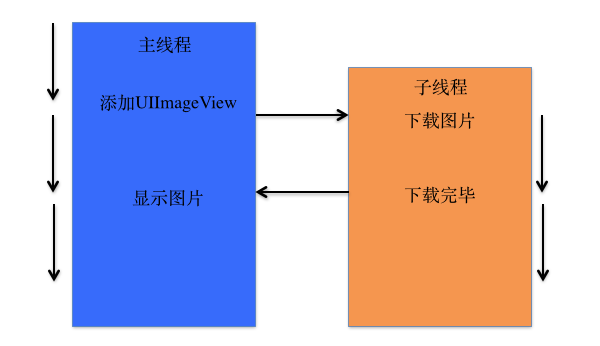
复制代码 代码如下:
//
// YYViewController.m
// 06-NSThread04-线程间通信
//
// Created by apple on 14-6-23.
// Copyright (c) 2014年 itcase. All rights reserved.
//
#import "YYViewController.h"
@interface YYViewController ()
@property (weak, nonatomic) IBOutlet UIImageView *iconView;
@end
复制代码 代码如下:
@implementation YYViewController
- (void)viewDidLoad
{
[super viewDidLoad];
}
-(void)touchesBegan:(NSSet *)touches withEvent:(UIEvent *)event
{
// 在子线程中调用download方法下载图片
[self performSelectorInBackground:@selector(download) withObject:nil];
}
-(void)download
{
//1.根据URL下载图片
//从网络中下载图片
NSURL *urlstr=[NSURL URLWithString:@"fdsf"];
//把图片转换为二进制的数据
NSData *data=[NSData dataWithContentsOfURL:urlstr];//这一行操作会比较耗时
//把数据转换成图片
UIImage *image=[UIImage imageWithData:data];
//2.回到主线程中设置图片
[self performSelectorOnMainThread:@selector(settingImage:) withObject:image waitUntilDone:NO];
}
//设置显示图片
-(void)settingImage:(UIImage *)image
{
self.iconView.image=image;
}
@end
代码2:
复制代码 代码如下:
//
// YYViewController.m
// 06-NSThread04-线程间通信
//
// Created by apple on 14-6-23.
// Copyright (c) 2014年 itcase. All rights reserved.
//
#import "YYViewController.h"
#import <NSData.h>
@interface YYViewController ()
@property (weak, nonatomic) IBOutlet UIImageView *iconView;
@end
复制代码 代码如下:
@implementation YYViewController
- (void)viewDidLoad
{
[super viewDidLoad];
}
-(void)touchesBegan:(NSSet *)touches withEvent:(UIEvent *)event
{
// 在子线程中调用download方法下载图片
[self performSelectorInBackground:@selector(download) withObject:nil];
}
-(void)download
{
//1.根据URL下载图片
//从网络中下载图片
NSURL *urlstr=[NSURL URLWithString:@"fdsf"];
//把图片转换为二进制的数据
NSData *data=[NSData dataWithContentsOfURL:urlstr];//这一行操作会比较耗时
//把数据转换成图片
UIImage *image=[UIImage imageWithData:data];
//2.回到主线程中设置图片
//第一种方式
// [self performSelectorOnMainThread:@selector(settingImage:) withObject:image waitUntilDone:NO];
//第二种方式
// [self.imageView performSelector:@selector(setImage:) onThread:[NSThread mainThread] withObject:image waitUntilDone:NO];
//第三种方式
[self.iconView performSelectorOnMainThread:@selector(setImage:) withObject:image waitUntilDone:NO];
}
//设置显示图片
//-(void)settingImage:(UIImage *)image
//{
// self.iconView.image=image;
//}
@end
线程安全
一、多线程的安全隐患
资源共享
1块资源可能会被多个线程共享,也就是多个线程可能会访问同一块资源
比如多个线程访问同一个对象、同一个变量、同一个文件
当多个线程访问同一块资源时,很容易引发数据错乱和数据安全问题
示例一:
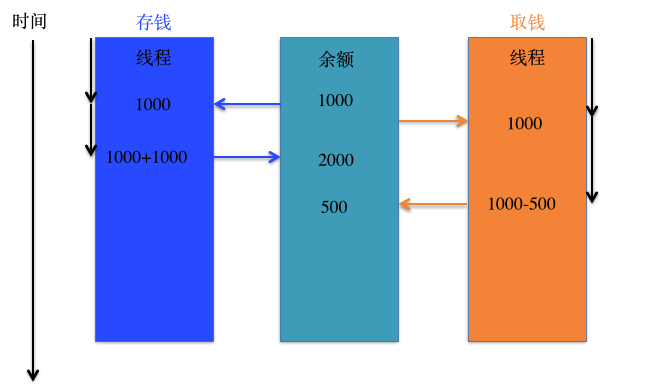
示例二:
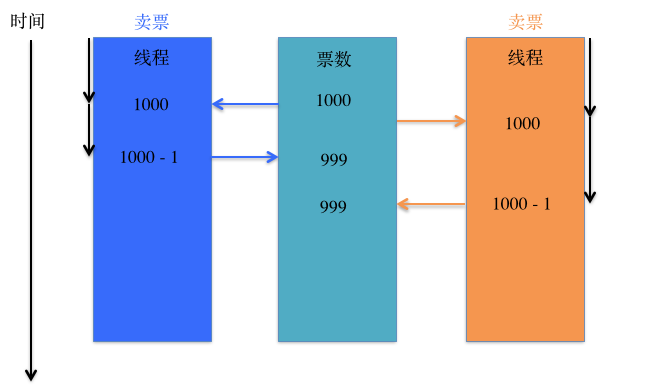
问题代码:
复制代码 代码如下:
//
// YYViewController.m
// 05-线程安全
//
// Created by apple on 14-6-23.
// Copyright (c) 2014年 itcase. All rights reserved.
//
#import "YYViewController.h"
@interface YYViewController ()
//剩余票数
@property(nonatomic,assign) int leftTicketsCount;
@property(nonatomic,strong)NSThread *thread1;
@property(nonatomic,strong)NSThread *thread2;
@property(nonatomic,strong)NSThread *thread3;
@end
复制代码 代码如下:
@implementation YYViewController
- (void)viewDidLoad
{
[super viewDidLoad];
//默认有20张票
self.leftTicketsCount=10;
//开启多个线程,模拟售票员售票
self.thread1=[[NSThread alloc]initWithTarget:self selector:@selector(sellTickets) object:nil];
self.thread1.name=@"售票员A";
self.thread2=[[NSThread alloc]initWithTarget:self selector:@selector(sellTickets) object:nil];
self.thread2.name=@"售票员B";
self.thread3=[[NSThread alloc]initWithTarget:self selector:@selector(sellTickets) object:nil];
self.thread3.name=@"售票员C";
}
-(void)sellTickets
{
while (1) {
//1.先检查票数
int count=self.leftTicketsCount;
if (count>0) {
//暂停一段时间
[NSThread sleepForTimeInterval:0.002];
//2.票数-1
self.leftTicketsCount= count-1;
//获取当前线程
NSThread *current=[NSThread currentThread];
NSLog(@"%@--卖了一张票,还剩余%d张票",current,self.leftTicketsCount);
}else
{
//退出线程
[NSThread exit];
}
}
}
-(void)touchesBegan:(NSSet *)touches withEvent:(UIEvent *)event
{
//开启线程
[self.thread1 start];
[self.thread2 start];
[self.thread3 start];
}
@end
打印结果:

二、安全隐患分析
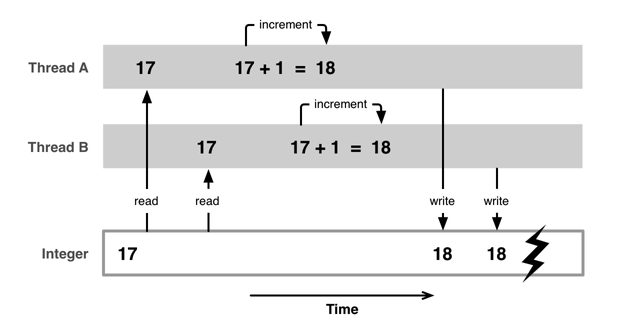
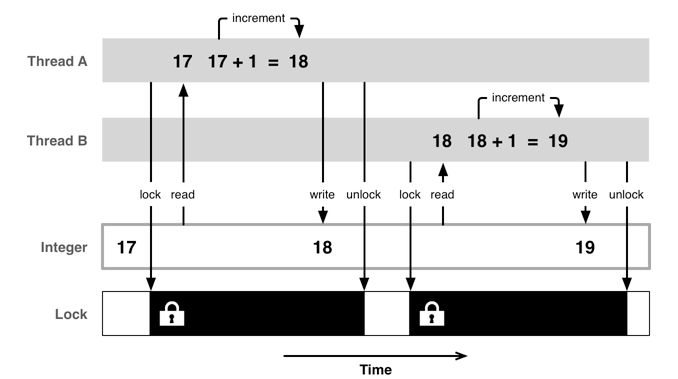
三、如何解决
互斥锁使用格式
@synchronized(锁对象) { // 需要锁定的代码 }
注意:锁定1份代码只用1把锁,用多把锁是无效的
代码示例:
复制代码 代码如下:
//
// YYViewController.m
// 05-线程安全
//
// Created by apple on 14-6-23.
// Copyright (c) 2014年 itcase. All rights reserved.
//
#import "YYViewController.h"
@interface YYViewController ()
//剩余票数
@property(nonatomic,assign) int leftTicketsCount;
@property(nonatomic,strong)NSThread *thread1;
@property(nonatomic,strong)NSThread *thread2;
@property(nonatomic,strong)NSThread *thread3;
@end
@implementation YYViewController
- (void)viewDidLoad
{
[super viewDidLoad];
//默认有20张票
self.leftTicketsCount=10;
//开启多个线程,模拟售票员售票
self.thread1=[[NSThread alloc]initWithTarget:self selector:@selector(sellTickets) object:nil];
self.thread1.name=@"售票员A";
self.thread2=[[NSThread alloc]initWithTarget:self selector:@selector(sellTickets) object:nil];
self.thread2.name=@"售票员B";
self.thread3=[[NSThread alloc]initWithTarget:self selector:@selector(sellTickets) object:nil];
self.thread3.name=@"售票员C";
}
-(void)sellTickets
{
while (1) {
@synchronized(self){//只能加一把锁
//1.先检查票数
int count=self.leftTicketsCount;
if (count>0) {
//暂停一段时间
[NSThread sleepForTimeInterval:0.002];
//2.票数-1
self.leftTicketsCount= count-1;
//获取当前线程
NSThread *current=[NSThread currentThread];
NSLog(@"%@--卖了一张票,还剩余%d张票",current,self.leftTicketsCount);
}else
{
//退出线程
[NSThread exit];
}
}
}
}
-(void)touchesBegan:(NSSet *)touches withEvent:(UIEvent *)event
{
//开启线程
[self.thread1 start];
[self.thread2 start];
[self.thread3 start];
}
@end
执行效果图

互斥锁的优缺点
优点:能有效防止因多线程抢夺资源造成的数据安全问题
缺点:需要消耗大量的CPU资源
互斥锁的使用前提:多条线程抢夺同一块资源
相关专业术语:线程同步,多条线程按顺序地执行任务
互斥锁,就是使用了线程同步技术
四:原子和非原子属性
OC在定义属性时有nonatomic和atomic两种选择
atomic:原子属性,为setter方法加锁(默认就是atomic)
nonatomic:非原子属性,不会为setter方法加锁
atomic加锁原理
复制代码 代码如下:
@property (assign, atomic) int age;
- (void)setAge:(int)age
{
@synchronized(self) {
_age = age;
}
}
原子和非原子属性的选择
nonatomic和atomic对比
- atomic:线程安全,需要消耗大量的资源
- nonatomic:非线程安全,适合内存小的移动设备
iOS开发的建议
- 所有属性都声明为nonatomic
- 尽量避免多线程抢夺同一块资源
- 尽量将加锁、资源抢夺的业务逻辑交给服务器端处理,减小移动客户端的压力
- 上一篇文章: 详解iOS开发中的转场动画和组动画以及UIView封装动画
- 下一篇文章: 实例讲解iOS应用UI开发之基础动画的创建